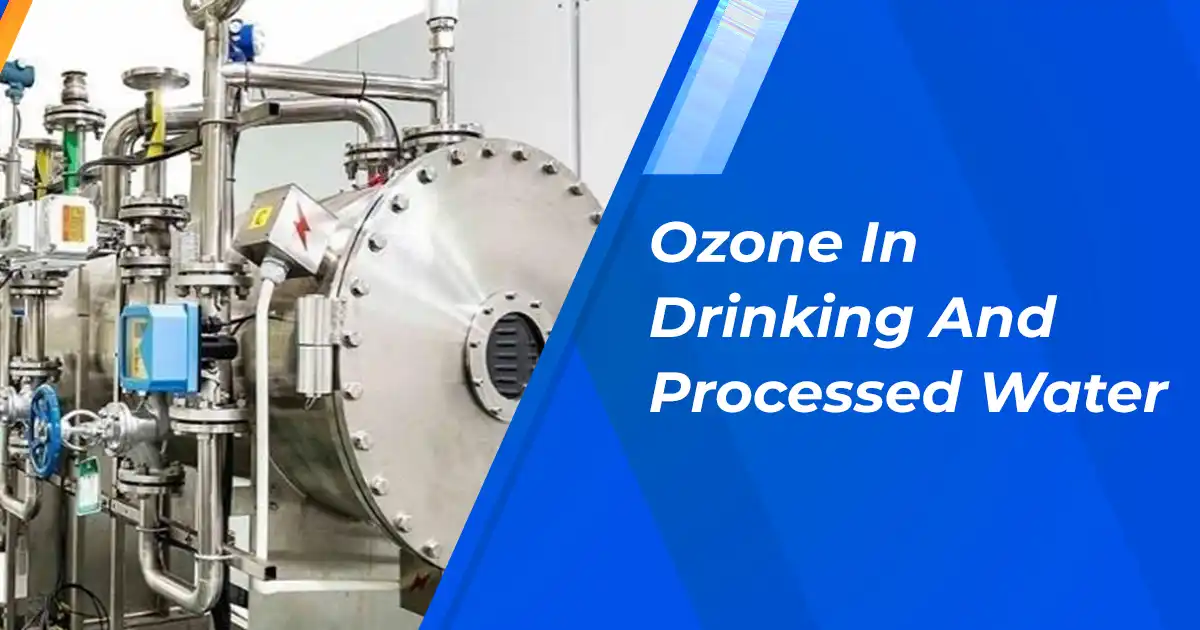Ozone In Drinking And Processed Water
Posted on: August 8, 2022

Ozone is a powerful oxidant and very widely used in drinking water treatment in the following applications
- Disinfection
- TOC reduction
- Taste enhancement
- Heavy metal removal
It is also extensively used in ‘process water treatment’. By virtue of its properties, it’s the most commercially available reactive substance (next to Fluorine).
Within water treatment, ozone finds use in various applications like:
- Municipal water treatment
- Industrial water treatment
- Packaged water treatment
- Process water treatment
- Swimming pool water treatment
- Cooling tower water treatment
- Aqua culture water treatment
- Horticulture water treatment
- Ballast water treatment etc.
Commercially, ozone is generated using ozone generators with air or Oxygen as a feed gas through the principle of corona discharge. For select applications, ozone is also generated directly from pure water [water-based or electrolytic ozone generators]. The ozone generated is then mixed in the process water using diffusers or venturies to achieve the necessary oxidation.
A commercial ozone generator

Ozone in municipal water treatment
Municipal water authorities resort to pre-ozonation instead of the conventional chlorination in many countries. Countries like Germany, France, Spain, China, Japan, Malaysia, Singapore, and in many plants in the US have ozone as the disinfectant of choice for pre-treatment .
In water works operation, classical oxidation agents such as chlorine, chlorine dioxide, ozone, etc are used mainly for destroying germs, algae and migratory shell larvae, and inactivating virus. Furthermore, these agents are used for the oxidation of Ammonia compounds and organic materials, break point chlorination, for elimination of iron and manganese and finally for polishing the water by removing the odor and taste causing substances as well as for micro flocculation.
But during oxidation with chlorine, undesirable reaction products often develop, example odor and taste active substances such as chloro-phenols. Depending on the type of oxidation agents used, toxic substances such as chlorites and chlorates or potentially carcinogenic matter such as THMs are produced.
It has been well established that the use of chlorine has resulted in the formation of chlorinated compounds such as chloroform that are highly toxic to human and known cancer causing chemicals.
During tests to minimize the problems of chloroform, chlorites and chlorates, it was noticed that a reduction of small dosage of chlorine dioxide can result in drastic fall in the chloroform and other THM contents in the water
No doubt that the diseases which can be transmitted by water can be eliminated by chlorination. This is precisely why when there is a taste of chlorine in water, people feel safe to consume the water and if there is no chlorine smell, the water should be left alone.
Ozone generator installed for municipal water treatment

Ozone as an oxidant
The use of ozone in drinking water provided the following uses
- Pre-disinfection for removal of bacteria
[including pseudomonas], virus and Giardia - Pre-oxidation for removal of organic compounds
- Oxidation of iron and manganese
- Improvement of the flocculation step –
- Algae removal
- Removal of color ,odor and improvement of taste
Ozone in packaged water
Packaged water Industry uses ozone during bottling of the product. BIS has made this compulsory before bottling approvals are given. Manufactures who do not have ozone in the production line are made to integrate ozone when they approach the BIS for annual renewals. What has made ozone compulsory in bottled/packaged water Industry?
While normal production process takes care of initial bacterial contamination, there are issues at a later stage during bottling. Also ozone provides other benefits while it provides a residual disinfectant level during bottling
The raw water undergoes initial chlorination, filtration (sand and carbon), RO and cartridge filtration and UV process before the water is sent for bottling. Also consumers do not like to smell chlorine in the bottled water. The initial process takes care of contamination, and chlorine residual before bottling. The process water meant for bottling does not cot contain any residual disinfectant to take care of contamination due to PET formed bottles, bottle caps, the bottling area and also contamination from the workers in the bottling area. Often it is found that contamination takes place at this level and bacterial growth is observed days after the products are sent to the market. QC samples may pass the test but products in the market could be contaminated and there is no assurance against this
Ozone provides this assurance. Manufacturers who use ozone before bottling will ensure that their product will be bacteria free for months after it leaves the factory. Ozone provides this residual disinfectant and takes care of accidental contamination through pet bottles, bottle caps, filling machines and from workers.
Dreaded Pseudomonas – The ozone solution
Pseudomonas is a gram-negative strain, dreaded by both pharmaceutical companies as well as hospitals. Gram-negative bacillus of late presents a major clinical significance; many instances of infections with these organisms have been noted regularly now. Infections include bacteraemia/septicaemia caused by contaminated solutions. Environmental studies have revealed that the organism can survive in chlorine-treated municipal water supplies, often colonizing sink basins and taps, intubation tubes, humidifiers, incubators for new-borns, ice chests and syringes, contaminated medical devices such as blood gas analysers, nebuliser equipment and has become a potential reservoir for infections in the hospital environment
Gram-negative bacteria are more susceptible to ozone than gram-positive organisms. Gram-negative organisms, fatty acid alkyl chains and helical lipoproteins are present. In acid-fast bacteria, such as Mycobacterium tuberculosis, one third to one half of the capsule is formed of complex lipids and glycolipids. The high lipid content of the cell walls of these bacteria may explain their sensitivity, and eventual demise, subsequent to ozone exposure. Ozone may also penetrate the cellular envelope, directly affecting cytoplasmic integrity, disrupting any one of numerous levels of its metabolic complexities.
“Pseudomonas has become the leading issue in pharmaceutical process water in India”
Preventing Bio films in the process industry using ozone
The water in most pharmaceutical Industry/hospitals are from sources outside and unknown to them. Water supplies are under contract to these water suppliers. This water is treated and used for all purposes including advanced treatment process for pharmaceutical compounding, water for injections in pharmaceutical companies and for all purposes in hospitals. Pseudomonas can pass through even advanced treatment process and emerge in the final product water. As these ordinary treatment processes continue, there is a formation of bio film in all the water pipes. Conventional bio films removal process such as CIP with hydrogen peroxide, per-acetic acid or even steam have not been found to be too effective against bio film removal. These bio films provide safe haven to most of these opportunistic bacteria and they proliferate when opportunity arises. The locations that has been identified are areas especially where there are increased storage facilities, and in areas where chlorine residuals are removed with SMBS.
Bio films can be classified as:
1) Primary films
2) Secondary films
Primary films are the bio films that have been formed and exist in layers on the surfaces of the tanks and pipes. Secondary films are bio films that are relatively new and appear in clusters on the surfaces or in the pipes. Ozone can remove exo-polysaccharides in the biofilm matrices and is very effective against biofilms against secondary bio films and can remove them totally with small amounts of residual ozone and lower contact time. Residual ozone of below 0.3 ppm, has found to be effective. Regular use of ozonated water will prevent formation of such bio films.
7 comments

Shreyas Baratharaj | Director
Sheryas Barathraj has over 15 years of experience in municipal and industrial ozone applications. He has worked on some of the world’s largest ozone installations, with key interests in advanced oxidation, chemical synthesis, pharmaceutical water systems, and municipal drinking water treatment. LinkedIn Bio ›



https://shorturl.fm/Eiojs
https://shorturl.fm/wMRvI
https://shorturl.fm/Iq3vt
https://shorturl.fm/l7FPp
https://shorturl.fm/xEufY
https://shorturl.fm/RDcW5
https://shorturl.fm/5qylV